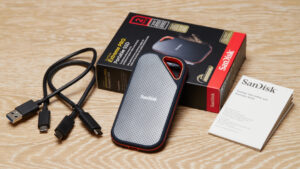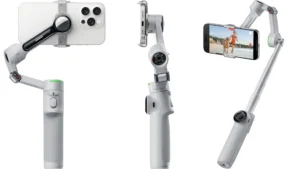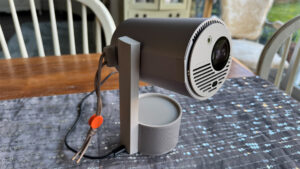There was a time when “working from your phone” meant compromise — a smaller screen, slower tools, and the quiet frustration of convenience over capability. But by 2026, that idea feels antique. The smartphone has outgrown its reputation as a pocket distraction. It has become the modern workstation — fluid, mobile, and alive with possibility.
We now build companies from cafés, edit films from flights, sketch blueprints from beaches. Productivity no longer lives in one place; it lives in motion. And the right accessories are what make this motion feel seamless — the bridge between power and portability.
The transformation isn’t just technological; it’s emotional. When a single device becomes your studio, your office, your canvas, you start to experience work differently. It feels lighter, more intentional. The clutter disappears — cables, adapters, multiple devices — replaced by a clean ecosystem designed for focus and flow.
That ecosystem begins with accessories built for precision and presence. A Keychron K3 Pro keyboard brings back the tactile joy of typing while your Anker MagGo dock keeps power flowing without clutter. An Apple Pencil Pro turns your screen into a sketchpad, while the Adonit Neo Pro extends that freedom to Android creators. Add the ASUS ZenScreen Go, and your phone becomes a dual-monitor setup — compact yet immersive.
For creators, tools like the Insta360 Flow Pro gimbal and XGIMI MoGo 3 projector transform any space into a mini studio or meeting room. Professionals find calm in Sony’s WF-1000XM6 earbuds, which mute chaos and sharpen thought. Meanwhile, the SanDisk Extreme Pro SSD and UGREEN Nexode Hub anchor everything — expanding memory, streamlining data, connecting worlds.
This is the new rhythm of digital life — one defined not by location, but by liberation. The phone is no longer just a window to the world; it’s a workspace that fits in your palm, powered by design that serves your mind.
Welcome to the age where efficiency meets elegance — where technology doesn’t overwhelm; it empowers.
The Anker MagGo 3-in-1 — Power Without the Tangle

Every productive day begins with power. Not speed, not storage, but the quiet assurance that your tools will keep up with you. The Anker MagGo 3-in-1 Wireless Charging Station captures that idea in its purest form — a single, sculptural hub that replaces the chaos of cables with an architecture of calm.
At first glance, it looks more like minimalist desk art than tech hardware: a smooth, Qi2-certified magnetic pad floating on an aluminum stem, supporting your phone at an ergonomic angle. Beneath, a hidden platform powers earbuds or a second device, while a subtle base ring holds your smartwatch in place. It’s the geometry of focus — clean, balanced, efficient.
Functionally, MagGo is as intelligent as it is elegant. Its Qi2 magnetic alignment system ensures precise, high-efficiency charging across iPhone 15/16 series and MagSafe-compatible Androids. Each contact point delivers up to 15 watts of wireless power, while the integrated USB-C port provides fast wired output for tablets or accessories. Inside, Anker’s ActiveShield 2.0 temperature control keeps everything cool, extending battery health — a detail most docks ignore but professionals quietly appreciate.
For remote workers and travelers, it’s more than convenience; it’s consistency. Drop your phone onto the stand, and within seconds, the screen shifts into standby productivity mode — displaying notifications, calendar tasks, or your focus timer. It’s a small ritual that replaces clutter with clarity. No more tangled cords or low-battery anxiety; just a desk that looks as composed as you feel.
A reviewer on Anker’s forum called it “the invisible assistant,” because you don’t notice it until you realize how peaceful your workspace has become. It embodies what modern productivity really means — not speed for its own sake, but energy that feels effortless.
When paired with a UGREEN Nexode Hub or Keychron K3 keyboard, MagGo becomes the anchor of a mobile ecosystem — powering the phone, while everything else flows around it. For creatives, it doubles as a magnetic mount for video calls or time-lapse recording; for professionals, it’s the calm center of a desk that travels.
By 2026, wireless power isn’t a luxury — it’s a mindset. A commitment to simplicity. The Anker MagGo 3-in-1 proves that even something as functional as charging can be emotional. It can invite stillness into work.
Because true productivity doesn’t begin with doing more — it begins with removing what gets in the way.
Keychron K3 Pro — Typing That Feels Like Thinking

There’s something deeply human about the sound of keys — the gentle rhythm of thought taking shape. In an era where we swipe, tap, and dictate, the act of typing remains grounding. It’s physical mindfulness, the bridge between intention and execution. And few tools capture that intimacy better than the Keychron K3 Pro, a low-profile mechanical keyboard built for creators who think through their fingertips.
At just 75% layout and under half an inch thick, the K3 Pro balances elegance with efficiency. Its aluminum frame feels sturdy yet featherlight, and every keystroke delivers a soft, satisfying click — not the harsh chatter of traditional mechanical keyboards, but a muted, intentional rhythm that feels like creative flow embodied.
For smartphone users, it’s transformative. Pair it via Bluetooth 5.1 or wired USB-C, and your phone becomes a full-scale writing studio. Whether you’re responding to emails, journaling, coding, or outlining a presentation, the K3 Pro gives you the precision of a laptop in a footprint that fits in a sling bag. It reconnects you with the pleasure of control — of shaping words, not just inputting them.
The keyboard supports multi-device pairing, allowing seamless transitions between your phone, tablet, or computer. Tap one key, and your typing jumps from your iPhone Notes app to your Galaxy’s Google Docs draft without missing a beat. That kind of fluidity is exactly what defines mobile productivity in 2026 — boundaries that disappear when design gets personal.
Under the surface, Keychron’s Gateron low-profile switches (available in tactile brown or linear red) offer customization that tech enthusiasts appreciate but newcomers instantly feel. There’s even an AI-assisted layout learning feature introduced in the 2025 update — it tracks usage patterns and suggests macro shortcuts for your most frequent phrases or commands. Subtle, invisible, yet incredibly empowering.
Paired with a UGREEN Nexode Hub and Anker MagGo dock, the K3 Pro becomes the center of a desk that travels. Fold out a portable stand, connect your phone, and suddenly you’re not “working from your phone” — you’re working with it. It turns the transient into the intentional.
A Reddit user described it best: “When I write on the K3 Pro, I feel like I’m thinking slower — in a good way.” That’s exactly the energy this keyboard brings: not speed for its own sake, but presence.
The Keychron K3 Pro proves that even in a world obsessed with automation, the most powerful productivity tool is still a well-designed interface between mind and motion.
Because when typing feels like thinking, the phone stops being a device — and starts becoming a companion.
Apple Pencil Pro & Adonit Neo Pro – Creativity in Your Palm

There’s a moment in every creator’s process — that thin space between idea and execution — where inspiration either slips away or takes form. In 2026, that moment fits in the palm of your hand. The stylus has evolved from accessory to extension; it’s no longer a gadget, but a bridge between imagination and immediacy.
The Apple Pencil Pro and Adonit Neo Pro embody this new era of creative control — two tools born from different ecosystems, united by the same promise: to make the screen feel like paper, and the digital feel human again.
Apple Pencil Pro – Precision Meets Emotion

Apple’s latest Pencil Pro, launched alongside the iPad and iPhone 15 Pro Max series, represents the culmination of a decade of iteration. But what makes this generation special isn’t just accuracy — it’s intimacy.
With pixel-perfect tilt and pressure sensitivity, haptic feedback, and a new squeeze gesture that lets you change brushes or tools mid-sketch, the Apple Pencil Pro has turned the iPhone into a creative studio that travels everywhere. Paired with apps like Procreate Pocket, Notability, or Adobe Fresco, it delivers an experience that feels as immediate as ink.
Designers use it to storyboard on the go. Architects annotate blueprints directly on-screen. Even marketers and writers find themselves sketching mind maps or signing proposals from cafés. The Pencil Pro’s near-zero latency means that the delay between thought and action — the friction of creation — has practically disappeared.
A freelance illustrator on Behance called it “the pen that breathes with me.” That description, poetic as it sounds, captures its magic perfectly: it’s an instrument of flow.
Adonit Neo Pro – Freedom Without Ecosystem Walls

For those beyond Apple’s garden, the Adonit Neo Pro is the democratized counterpart — elegant, accessible, and equally capable. Compatible with both Android and iOS, it brings magnetic attachment, USB-C fast charging, and palm rejection to a wider creative world.
The Neo Pro is ideal for note-takers, digital planners, and artists who sketch on Samsung Notes, Concepts, or Sketchbook. Its fine 1mm tip captures subtle motion — from handwriting to detailed shading — while its durable aluminum body feels premium in hand. One charge delivers up to nine hours of active use, and its auto-sleep mode preserves energy during travel.
What makes it stand out isn’t just affordability; it’s accessibility. It invites creativity into the everyday. Students, journalists, and travelers use it to annotate PDFs, brainstorm in airports, or capture spontaneous ideas in motion. It’s the analog spirit reborn in digital form.
Together, the Apple Pencil Pro and Adonit Neo Pro show that creativity isn’t confined to studios or offices anymore. It’s mobile, intuitive, and inclusive.
In the right hands, these styluses aren’t just tools — they’re translators of thought. They turn notes into strategy, doodles into design, and sketches into prototypes. And more importantly, they make the act of creating feel playful again.
Because when you can draw, write, and imagine on the same screen where you communicate, productivity becomes something deeper — a kind of connection between inner clarity and outer action.
In that sense, these pens aren’t competing with paper; they’re competing with distraction. They’re about slowing the mind to the pace of intention.
By 2026, the stylus has stopped being an optional accessory. It’s now a compass — pointing creativity back toward focus, one gesture at a time.
SanDisk Extreme Pro SSD – Speed That Frees You

Every creator, freelancer, and modern professional knows the quiet dread of the “storage full” alert — that moment when your phone stops being a tool and starts being a limitation. In 2026, when most of our work lives inside our devices, speed and space are not luxuries; they’re liberation. The SanDisk Extreme Pro Portable SSD (2TB) captures that liberation in its purest, most portable form — freedom measured in gigabytes and seconds.
You feel it the first time you hold it: small enough to slip into a pocket, yet built like it could survive a lifetime of airports, edits, and deadlines. The rugged aluminum body, wrapped in a textured silicone shell, isn’t about style — it’s about security. This is a drive designed for motion.
Under that quiet exterior lies USB 3.2 Gen 2×2 technology, capable of delivering transfer speeds up to 2,000 MB/s. To put that in perspective: it can move an entire 4K video project from your phone to backup in less time than it takes to refresh your coffee. Paired with a USB-C smartphone or hub, it becomes the silent assistant behind every digital workflow — whether you’re exporting raw footage, transferring design files, or simply archiving your day.
For content creators and digital nomads, the Extreme Pro is more than just storage — it’s peace of mind. With 256-bit AES hardware encryption, password protection, and shock resistance up to two meters, it guards not only your data but your creative security. And when paired with a UGREEN Nexode Hub, it integrates seamlessly into your mobile workstation setup — phone, display, SSD, all connected in a single cable ecosystem.
SanDisk has also perfected reliability in subtler ways. The Dynamic Thermal Guard prevents overheating during long transfers, while the NVMe architecture ensures consistent speed without the frustrating slowdowns that plague cheaper drives. It’s not just fast once — it stays fast.
A freelance filmmaker described it best on a Reddit thread: “It’s the only drive I trust at the end of a 14-hour shoot.” That’s the emotional truth of it — reliability isn’t just technical; it’s psychological. It’s knowing that your ideas are safe, your time is respected, and your tools won’t fail when you need them most.
The SanDisk Extreme Pro SSD isn’t trying to impress; it’s trying to disappear — to be the invisible part of your workflow that you never have to think about. That’s the real definition of productivity: when technology becomes so seamless, it lets you focus on what matters — the work, not the waiting.
In a world where our phones are our offices, this little drive is the vault that makes freedom possible.
Because creativity doesn’t just need space — it needs trust.
ASUS ZenScreen Go – The Window That Expands Your World

For all the power that lives inside a smartphone, one limitation has always lingered — space. Not storage, but visual space. There’s only so much you can create, design, or present on six inches of glass. The ASUS ZenScreen Go MB16AP exists to dissolve that boundary, transforming your phone from a solo performer into a full production stage.
Imagine setting down your phone, connecting a single USB-C cable, and watching your workspace bloom into a 15.6-inch canvas. Emails glide beside spreadsheets, sketches unfold beside notes, and video edits stretch into clarity. The ZenScreen Go doesn’t just add pixels — it adds presence.
Its Full HD IPS display renders colors with gentle precision: bright without harshness, vivid without exaggeration. The auto-rotate sensor adjusts instantly as you shift orientation, and the built-in 7800 mAh battery gives up to four hours of untethered operation — enough to review projects on a train or pitch ideas in a café. The design itself is impossibly slim, weighing barely 900 grams, sliding into a sleeve alongside your tablet or keyboard without demanding its own space.
But what makes the ZenScreen Go so uniquely 2026 isn’t just its hardware; it’s its attitude. It reflects a world that’s mobile, fluid, collaborative. You can pair it with a Samsung DeX-enabled phone and instantly open a desktop interface — multitasking windows, editing tools, and browser tabs, all running from your pocket device. Connect it to a UGREEN Nexode Hub, and suddenly you have a full ecosystem: keyboard, SSD, charger, and display — everything powered by one cable.
For designers, it becomes a portable artboard; for filmmakers, a mobile preview monitor; for professionals, a presentation surface you can unfold anywhere. Reviewers often describe it as “the screen that makes you forget you’re on a phone,” and that’s precisely the point — to erase that old boundary between mobile and meaningful work.
The ZenScreen Go carries a subtle emotional charge, too. When you set it up on a café table or hotel desk, it signals intention. You’re not just passing time; you’re creating it. The matte finish resists glare, the foldable stand adjusts smoothly, and together they invite focus — the kind that turns distraction into discipline.
In 2026, productivity isn’t about being chained to a desk; it’s about making space anywhere. The ZenScreen Go doesn’t shout innovation — it whispers it, through clarity, balance, and portability.
Because sometimes, the only thing standing between thought and vision is a few more inches of light.
Insta360 Flow Pro – The Mobile Studio in Your Hand

In 2026, the smartphone is no longer just a communication tool — it’s a storytelling engine. Whether you’re a content creator, entrepreneur, or remote professional, visual communication is now as essential as writing a sentence. And among all the tools redefining mobile creativity, none has made it as intuitive as the Insta360 Flow Pro.
At first glance, the Flow Pro looks modest — a sleek, foldable gimbal small enough to slip into a jacket pocket. But the moment it powers on, it transforms the phone into something more deliberate: a precision camera system guided by AI, stabilized by motors that react faster than your own reflexes. It’s cinematic control without the bulk of a rig.
The Flow Pro’s standout feature is its Deep Track 3.0 system — powered by advanced subject recognition and predictive framing. It doesn’t just follow you; it anticipates movement. Whether you’re walking through a city, demonstrating a product, or recording a podcast clip, the gimbal adjusts in real-time, keeping the focus perfectly balanced. You can wave your hand to start tracking, rotate your wrist to switch orientation, or tap to shift subjects — all without touching the screen.
For solo creators, this feels liberating. No need for an extra camera operator or complex setup — just attach your phone magnetically, unfold the arm, and press record. Within seconds, you have a professional-grade shot ready for editing or streaming. The AI Auto Mode selects optimal stabilization strength, tilt, and zoom depending on context — whether you’re filming a steady talking-head video or capturing motion-heavy sequences.
Battery life stretches comfortably past 12 hours, enough for a full day of content capture. It doubles as a power bank, charging your phone while recording — a small but critical detail that separates hobbyist gear from professional-grade tools.
But beyond performance, what makes the Insta360 Flow Pro special is what it enables. It bridges creativity and efficiency — allowing marketers, journalists, teachers, and vloggers to record, present, and share instantly. Pair it with the XGIMI MoGo 3 projector, and you can screen your footage for a client on the spot. Connect it to the SanDisk Extreme Pro SSD, and offload 8K clips in seconds.
This isn’t about being a “YouTuber” or influencer anymore — it’s about mastering visual clarity in a world that increasingly communicates through video. Whether you’re capturing tutorials, virtual tours, or team updates, the Flow Pro turns the smartphone into a complete mobile studio.
As one user put it on Reddit: “It doesn’t just stabilize my footage — it stabilizes my workflow.”
That line captures the essence of where creative tech is heading. The Flow Pro doesn’t try to replace human skill; it amplifies it. It makes storytelling seamless, so that creativity feels less like production and more like instinct.
Because in 2026, the story that moves people most is often the one that fits right in your hand.
XGIMI MoGo 3 – Presentations Without Borders

If there’s one moment that defines modern work, it’s the spontaneous presentation — that instant when a client meeting moves from conversation to demonstration, and you need your ideas to fill the room. The XGIMI MoGo 3 exists for exactly that moment. It’s the kind of device that turns any wall, café corner, or hotel ceiling into a full cinematic display — quietly erasing the line between office and everywhere else.
At first glance, it looks like a compact speaker — minimalist matte casing, the size of a thermos, no unnecessary buttons or screens. But power it on, and it projects a 4K HDR image up to 200 inches wide, with brightness levels that defy its size. It’s powered by XGIMI’s X-Vue 3.0 image engine, delivering crisp contrast, accurate color balance, and automatic keystone correction that takes seconds. No fiddling, no alignment stress — just open, project, and present.
What makes it so relevant in 2026 isn’t only its image quality but its mobility. The MoGo 3 weighs just under 1kg and packs a 60Wh internal battery, giving nearly 4 hours of wireless playback — or a full afternoon of meetings. It connects directly to your smartphone via Wi-Fi 7 screen mirroring or USB-C video output, supporting both Android and iOS devices without the usual adapter chaos.
For professionals, it’s transformative. Open a pitch deck on your phone, tap “Cast,” and within seconds, your slides fill the room. For designers, it’s an impromptu mood board. For filmmakers and content creators, it’s an instant review screen. Pair it with the Sony WF-1000XM6 earbuds, and you can preview video or audio privately even while projecting publicly.
But the MoGo 3’s magic isn’t just technical; it’s atmospheric. The built-in Harman Kardon stereo speakers fill a space with warmth and depth, turning sterile hotel rooms into creative spaces. The projector’s smart auto-focus adjusts seamlessly as you move it closer or farther, so collaboration never breaks rhythm. Whether you’re hosting a late-night client session or screening your short film after a shoot, it makes presentation feel natural — even poetic.
Perhaps that’s why so many early adopters describe it as the “freedom projector.” It’s not about the specs (though they’re impressive); it’s about presence — the ability to make your ideas tangible anywhere you go.
In 2026, mobility is no longer about moving fast; it’s about moving fully equipped. The XGIMI MoGo 3 embodies that principle: a tool that doesn’t just help you share what’s on your screen, but what’s on your mind.
Because when your work can fill a wall, your world suddenly feels a little larger.
UGREEN Nexode Hub – The Power to Connect Everything

Behind every sleek, mobile workstation lies one humble truth: nothing works alone. The phone, the keyboard, the SSD, the display — they’re all fragments of potential until something binds them together. The UGREEN Nexode 11-in-1 Hub is that quiet connector, the small device that transforms possibility into precision.
It’s understated — a slim slab of brushed metal that could pass for a portable drive, but inside it carries the muscle of a desktop dock. Plug it into your smartphone, and suddenly you have a world of ports: HDMI 8K, dual USB-A, dual USB-C PD, SD and microSD slots, Ethernet, and even 3.5mm audio. It’s a bridge between every modern accessory and the mobile future we’ve been promised for years.
What sets the Nexode apart from older hubs is its intelligence. UGREEN’s 2026 edition integrates an AI-powered power distribution chip, which analyzes connected devices in real time and allocates wattage dynamically — ensuring your Anker MagGo charger, ASUS ZenScreen Go, and SanDisk SSD all draw power efficiently without overheating. For professionals who travel or operate hybrid setups, this isn’t convenience — it’s control.
It also supports DisplayLink technology, allowing a smartphone running Samsung DeX, Motorola Ready For, or even iPadOS-like desktop modes to drive two external displays simultaneously. That means your phone can run a presentation on the XGIMI MoGo 3 while mirroring notes to the ZenScreen Go — all powered from one cable.
The Nexode’s material design feels aligned with the 2026 aesthetic: minimalist, practical, and quietly luxurious. The matte gunmetal finish resists fingerprints, the ports are lined with subtle LED indicators, and the integrated cooling vents keep performance steady during long work sessions. It’s not a gadget you show off — it’s one you depend on.
But perhaps the greatest value of the Nexode Hub is invisible. It’s the emotional calm that comes from a workspace that just works. No adapters, no tangled cords, no sudden disconnects. Everything flows — from file to display, from creativity to collaboration.
For remote professionals, it’s the difference between feeling mobile and feeling fragmented. Plug it in, and you’re instantly grounded.
One reviewer on a productivity subreddit captured it perfectly: “The Nexode doesn’t add power; it organizes it.” That’s the secret to true productivity in 2026 — not more tools, but harmony among them.
In many ways, the Nexode Hub represents the final piece of the modern puzzle — the quiet intelligence that lets your smartphone become not just a device, but a desk, studio, and control center in one.
Because in the end, progress isn’t about adding complexity — it’s about finding balance in connection.
Reflection – When Simplicity Becomes Power
If there’s a single thread connecting the devices of 2026 — from the magnetic calm of the Anker MagGo to the composure of the UGREEN Nexode Hub — it’s not technology. It’s intention. Each of these tools was designed to restore something we’ve lost in the noise of modern work: focus, fluidity, and the quiet satisfaction of systems that serve us instead of distracting us.
The smartphone has finally completed its evolution from communication device to creative hub. Yet, what makes this transformation meaningful isn’t raw performance — it’s the harmony created when every accessory works together like a symphony of design. The Keychron K3 Pro brings rhythm back to writing. The Apple Pencil Pro and Adonit Neo Pro give hand and thought a shared language. The SanDisk Extreme Pro SSD turns digital clutter into order. And with a ZenScreen Go, we stretch the boundaries of a small screen into a full workspace.
Together, they shape an ecosystem where productivity no longer looks like pressure — it looks like clarity.
What’s remarkable is how deeply emotional this shift feels. These aren’t gadgets; they’re extensions of human intention. The Sony WF-1000XM6 doesn’t just cancel noise — it creates space to think. The Insta360 Flow Pro doesn’t just stabilize footage — it stabilizes creative confidence. And the XGIMI MoGo 3 reminds us that ideas are meant to be seen, not hidden on a six-inch screen.
By the time everything connects through the UGREEN Nexode Hub, the smartphone stops feeling like a compromise and starts feeling like liberation — a complete, self-contained universe of work, art, and imagination.
This is where technology feels human again. Not because it’s smaller or faster, but because it’s quieter, more intentional, and aligned with how we actually live. It doesn’t demand attention; it rewards it. It doesn’t compete for control; it collaborates.
In that sense, productivity in 2026 isn’t about efficiency alone. It’s about emotional ergonomics — tools that help us focus, create, and breathe in the same motion.
The best tech no longer dazzles; it disappears. It fades into the background, leaving only clarity — that rare feeling when you realize you’ve been working for hours, not fighting your tools but flowing through them.
Because the future of work isn’t about doing everything everywhere. It’s about doing the right things, beautifully, anywhere.
And if one small device can power that kind of calm — maybe simplicity has always been the most powerful form of innovation.

